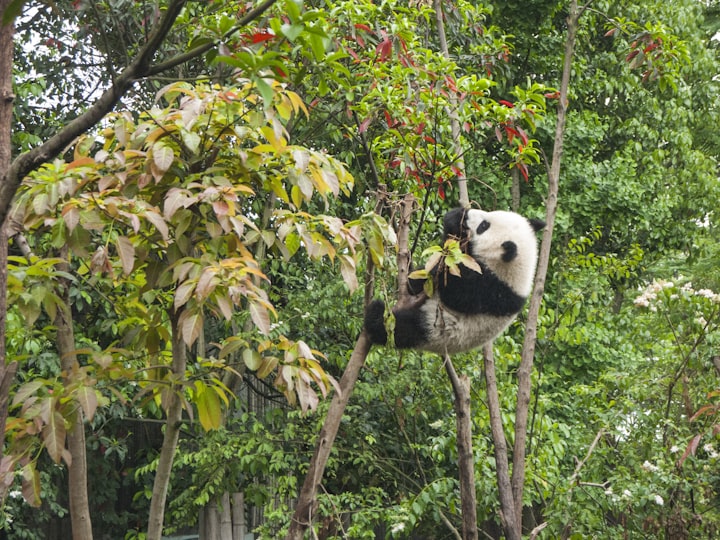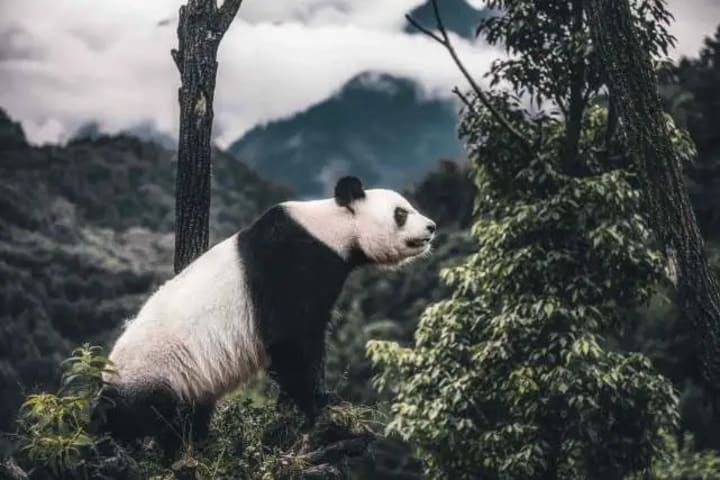How difficult is it for giant pandas to mate?
National Treasure Giant Panda

The image of the giant panda can now be seen all over the world, and its popularity and influence have become synonymous with China.
The gradual recovery of the giant panda from its past critically endangered status is inseparable from the conservation efforts of China's giant pandas, and the efforts of many of our researchers have finally pulled this special species back from the brink of extinction.
However, it is important to understand that while the giant panda is being cared for by humans today, it is still a vulnerable species.
Its continued habitat loss and habitat fragmentation, as well as its extremely low birth rate in the wild and captivity, have kept the giant panda from being in danger of survival.
Giant pandas have been a captive species since as early as the Western Han Dynasty in China.
Even the great writer Sima Xiangru commented that the giant panda was the most precious animal in the capital Chang'an's exotic zoo, as a result of its peculiar appearance and naive figure.
However, wild giant pandas are secretive and generally difficult to be found, and the captive environment has not been improved in the past, and is so difficult that giant pandas have been recorded in history only in individual dynasties.

It was not until the 1950s that giant pandas appeared again in Chinese zoos for exhibition.
Perhaps people have the impression that giant pandas spend their days gnawing on bamboo, which does not seem to cost much to raise.
But in reality, giant pandas are quite demanding in terms of living environment and food requirements. The size of an elephant and the amount of food it eats are comparable, but compared to that, the cost of raising a giant panda is five times that of an elephant.
In the past, there were great drawbacks and limitations in raising giant pandas in captivity due to backward domestic management and inadequate knowledge of giant pandas.
In the early days, the most common approach to raising pandas was to capture them directly from the wild for captive breeding, which made many research bases a cage for pandas.
In addition, early research efforts did not study the dietary habits of pandas in detail, and the physiological effects of bamboo on pandas were ignored.

In addition, in the early days, guns were not completely banned in the country, which led to a great challenge to the habitat and survival of giant pandas.
Almost since ancient times, giant pandas have been the target of many poachers, especially during the Anti-Japanese War and the Nationalist-Communist Civil War, when the pandas suffered particularly badly from poaching.
Fortunately, through the efforts of researchers, the number of giant pandas in the wild has grown in the past from 1,114 in 1985 to 1,596 in 2004.
By 2016, the International Union for Conservation of Nature had adjusted the giant panda from endangered to vulnerable on the Red List as their numbers continued to increase.

Why Giant Panda Breeding Efforts Are Difficult
Giant pandas, even today, remain a major challenge for wildlife conservation and captive breeding, which is inseparable from the habits, living conditions, and breeding characteristics of giant pandas.
In terms of distribution, giant pandas live mainly in the bamboo forests of the Qinling Mountains and the hills of Sichuan and are solitary animals.
Each giant panda has its range of activity, and except for the period of estrus when pandas communicate with each other, most of the year is a state of old age.
Intimate communication is not common among giant pandas
In addition, their gender determines their range of activity, with females having a larger range than males, and males having nesting overlaps.
However, female pandas cannot accept overlapping ranges with other pandas, which makes the activities of pandas naturally spontaneous.
Giant pandas communicate mainly through vocalizations and scent marks, such as rubbing against trees or spraying urine.

Since pandas do not build permanent nests, they move to warmer areas in the winter.
Over millions of years of evolution, pandas have evolved from their early omnivorous nature to a primarily herbivorous one.
Although their digestive system still retains the ability to digest meat, they prefer to eat bamboo.

In addition to bamboo, wild pandas also eat insects, bamboo rats, goats, etc. Scientists believe that pandas evolved with the inactivation of the T1R1 gene, which dulled their perception of the fresh taste of meat.
In this way, even if a delicious piece of fresh meat is placed in front of them, it is difficult to impress them.
But then again, herbivory is hardly a nutritional supplement for pandas, not to mention the low nutrition and energy content of bamboo itself.
The main components of bamboo are cellulose and lignin, and for this reason, giant pandas will eat bamboo for most of the day, relying on starch, hemicellulose, and trace amounts of protein in bamboo for their energy source.
So we can see that although giant pandas eat bamboo, it is not just any bamboo.
For this reason, pandas have evolved to reduce their body surface area and metabolism to alleviate the problems caused by inadequate caloric intake, so pandas in zoos either sit and gnaw on bamboo or lie on their backs to bask in the sun.
The habitat destruction brought about by human activities and the reduction of bamboo forests are the reasons why the living environment of giant pandas has been so severely affected.
From the perspective of reproduction, the low estrus rate of giant pandas and the difficulty of living in the wild are other major factors affecting the reproduction of giant pandas.
The sexual maturity of giant pandas takes at least four years, and the reproductive age is up to 20 years old, with a fixed mating period from March to May every year.
At this time, males will locate females by scent, but female pandas will still choose the genetically better male.
Male pandas also fight with their kind for this reason during breeding.
This is avoided in captivity, and conservation efforts are primarily conducted through artificial insemination.
Successfully conceived pandas give birth to one to two cubs at a time every two years, but in the wild, only one usually survives.
While pandas in the wild can maintain good conditions as long as they can ensure a normal life and a stable environment, the problem is that while wild pandas are scarce today, pandas bred in captivity have many problems.
This makes rewilding pandas very difficult.
What is a national treasure?
Once a giant panda is removed from the wild, there is a change in temperament, or to be precise, a serious reduction in the desire to mate.
Originally, in the natural environment, the rutting period of giant pandas is very short, usually only one or two days, but the ratio of rutting performance and reproductive behavior of wild pandas is 100%.
In contrast, only 26% of captive-bred giant pandas.
Even after many breeding sessions, pandas can become uninterested in mating, and researchers have shown educational films to pandas to help them build the right perceptions.
Several other factors contribute to this is that people do not know enough about pandas in the early days. Wild pandas are usually weaned 8 to 9 months after the birth of their cubs.
However, in the early days of captivity, cubs were forcibly weaned for separation just after 6 months in order not to interfere with the female's ability to breed the next generation.
However, this results in pandas not having a clear understanding of their reproduction, and pandas released into the wild may leave their cubs prematurely.
Originally, bears face nutritional deficiencies when breeding their offspring, and bamboo can bring limited nutrition to females, so female pandas will often go out to eat to meet stimulate milk production.
Collectively, the inability to effectively breed spontaneously, as well as the low survival rate in the wild and the inconspicuous estrus period, are important issues that prevent giant pandas from being able to reproduce effectively today.
Scarcity is one reason it is a national treasure, and many other considerations go into the selection of national treasures.
In addition to reflecting economic value, the giant panda must be a unique species in China.
Secondly, it can reflect the cultural characteristics of the country and can represent the image of the country.
The appearance of the giant panda is only black and white, just like the Taoist totem of yin and yang, while Taoism has a deep influence as a native Chinese religion.
The extremely symmetrical color distribution of the giant panda reflects the Taoist culture of yin and yang in opposition to each other and coexistence.
In ancient times, the image of the giant panda was even worshipped as a mountain god by local regions.
From the Confucian culture, the giant panda is mainly vegetarian, almost non-aggressive, and able to live in harmony with other species.
It thus embodies subtlety and introspection and is not subservient. In addition, giant pandas have a mild temperament and a naive image, which is especially important in giant panda diplomacy.
The popular elements and cultural image brought by the giant panda, which is synonymous with China, have made China's image in the world more affable and its cultural significance far higher than that of the rare species itself.
Therefore, today, protecting and breeding giant pandas has also become an important element for many animal researchers in China, and is a well-deserved national treasure.
About the Creator
Turnell Feliu
People who shiver from the cold can best appreciate the warmth of the sun. Those who have experienced life's troubles know best the preciousness of life






Comments
There are no comments for this story
Be the first to respond and start the conversation.